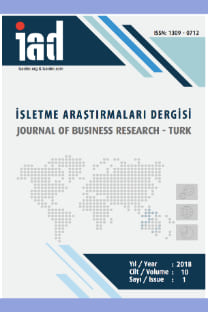Performance Measurement and Reporting in Lean Manufacturing Environment: Integration of Balanced Scorecard and Lean Accounting Box Score
___
Armstrong, M., Baron, A. (2005). Managing Performance: Performance In Action, Chartered Institute of Personnel Development, London.Balcı, B.R. (2011). Yalın Düşünce ve Muhasebe. Dokuz Eylül Üniversitesi Sosyal Bilimler Dergisi, 13(1), 39-58.
Banker, R.D., Chang, H. And Pizzini, M.J. (2004). The Balanced Scorecard: Judgmental Effects of Performance Measures Linked to Strategy. The Accounting Review, 79(1), 1-23.
Bhasin, S. (2008). Lean and Performance Measurement, Journal of Manufacturing Technology Management, 19(5), 670-684.
Baroma, B., Bellisario, A., Chirico, A. and Appolloni, A. (2013). Breakthroughs in the Management Accounting Science: Imaging a Balanced Scorecard Thought by Lean Philosophy Rationales, Transition Studies Review, Springer;Central Eastern European University Network (CEEUN), vol. 20(2), 239-251.
Cesoroni, F. M. and Sentuti, A. (2014). Implementing a Lean Accounting System in a Lean Enterprise. 18 th International Academy of Management and Corporation”, (IAMB) Conference Paper, 17-20 September, Italia, Università Roma.
Coşkun, A. (2007). Stratejik Performans Yönetimi ve Performans Karnesi, Literatür, Istanbul.
Dahlgaard, J.J, and Dahlgaard‐Park, S.M. (2006). Lean Production, Six Sigma Quality, TQM And Company Culture. The TQM Magazine, 18(3), 263-281. http://www.emeraldinsight.com/doi/pdfplus/10.1108/09544780610659998
Elitaş, C. and AĞCA, V. (2006). Firmalarda Çok Boyutlu Performans Değerleme Yaklaşımları. Afyon Kocatepe Üniversitesi Sosyal Bilimler Dergisi, VIII (2), 343-370.
Ghalayini, A.M. and Noble, J.S. (1996). The changing basis of performance measurement. International Journal of Operations & Production Management, 16(8), 63-80.
Hines, P., Holweg, M. And Rich N. (2004). Learning to Evolve A Review of Contemporary Lean Thinking. International Journal of Operations & Production Management, 24(10), 994-1011.
Itter, C.D., Larcker, D.F. (1998). Innovations in Performance Measurement: Trends and Reseacrh Implications. Journal of Management Accounting Research, 10, 205-238.
Kaplan, R. S. and Norton, D. P. (1992), The Balanced Scorecard measures that drive performance. Harvard Business Review, 70(1), 71-79.
Kaplan, R. S. and Norton, D. P. (1996). Using the Balanced Scorecard As A Strategic Management System. Harvard Business Review, 74(1), 75-85.
Kaplan, R. S., and Norton, D.P. (2004a) "Measuring the Strategic Readiness of Intangible Assets." Harvard Business Review, 82(2), 52-63.
Kaplan, R. S. and Norton, D. P. (2004b). The strategy map: guide to aligning intangible assets. Strategy and Leadership, 32(5). 10-17.
Kaplan, R. S. and Norton, D. P. (2007). Balanced Scorecard, Sistem, İstanbul.
Karlsson, C. and Ahlstrom, P. (1996). Assessing Changes Towards Lean Production. International Journal of Operations and Production Management, 16(2), 16-24.
Katko, N. (2014). Yalın CFO-, Optimist, Istanbul.
Kennedy, F.A. and Brewer, P.C. (2006). The Lean Enterprise and Traditional Accounting – Is The Honeymoon Over. Journal of Corporate Accounting And Finance, 17(6), 63-74.
Lebas, M.J. (1995). Performance Measurement and Performance Management. International Journal of Production Economics, 41(1-3), 23.35.
Lopez, P., Santos, J.& Arbos, L. (2013). Lean Manufacturing: Costing The Value Stream. Industrial Management & Data System, 113(5), 647-668.
Maraşlı, H., Coban, M.C. ve Topbaş, E. (2014). Yalın Muhasebe”, KSÜ Sosyal Bilimler Dergisi, Cilt.11, Sayı:2, 25-39.
Maskell, B. H. and B. L. Baggaley. (2006). Lean Accounting: What's İt All About? Target Magazine 22(1), 35-43.
Maskell, B.H. (2006). Solving The Standart Cost Problem. Cost Management, 20(1), 27-35.
Maskell, B.H., Baggaley, B., Katko, N. and Paino, D. (2007). The Lean Business Management System, First Edt., BMA inc., USA.
Maskell, B.H. (2015). Metrics that Matter. https://www.cob.calpoly.edu/centralcoastlean/wpcontent/ uploads/sites/6/2017/07/Metrics-That-Matter-AMweb.pdf
Melton, T. (2005). The Benefits of Lean Manufacturing: What Lean Thinking has to Offer the Process Industries. Chemical Engineering Research and Design, 83(6), 662–673.
Mcvay, G., Kennedy, F. and Fullerton, R. (2013). Accountin in the Lean Enterprise: Providing Simple, Practical, and Decision-Relevant Information. Productivity Press, New York.
Niven, P.R. (2002), Balanced Scorecard. John Wiley & Sons Inc, New York.
Onofrei, G. and Prester, J.(2017). The Impact of Operational Intellectual Capital on Lean Practices. 24th EurOMA Conference,01-06 June 2017, Edinburg.
Özbirecikli, M. and Ölçer, F. (2002). Strateji Odaklı Performans Ölçüm Sistemi: Balanced Scorecard. İstanbul Üniversitesi İşletme Fakültesi Dergisi, 31(2),31-48.
Özçelik, F. and Ertürk, H. (2010). Yalın Üretim İşletmeleri İçin Değer Akış Yönetimi ve Değer Akış Maliyetlemesi (DAM). Uludağ Üniversitesi İktisadi ve İdari Bilimler Fakültesi Dergisi, 29(2), 51 – 84.
Sağmanlı, M. and Ersen, Ç. (2001). Balanced Scorecard ve Stratejik Odaklı Kurum. Öneri, 4(16), 127-132.
Sanger, M. (1998). Supporting The Balanced Scorecard. Work Study, 47(6) 197-200.
Stenzel, J. (2007). Lean Accounting Best Practices for Sustainable Integration, John Wiley&Sons, New Jersey.
Thangarajoo, Y. and Smith, A. (2015). Lean Thinking: An Overwiev. Industrial Engineering & Management, 4(2) https://www.omicsonline.org/open-access/lean-thinking-an-overview-2169-0316- 1000159.php?aid=53404
Uzun Kocamış, T. (2015). Lean Accounting Method for Reduction in Production Costs in Companies. International Journal of Business and Social Science, 6(9), 6-13.
Woehrle, S.L. and Abou-Shady, L. (2010). Using Dynamic Value Stream Mapping And Lean Accounting Box Scores To Support Lean Implementation. American Journal Of Corporation Education, 3(8), 67-76.
Womack, J.P., Jones, D.T. and Roos, D. (1990). The Machine That Changed The World, Rawson Associated, New York.
Womack, J.P. and Jones, D.T. (2003). Lean Thinking: Banish Wast and Create Wealth in Your Corporation, NY Free Press, Simon & Schuster Inc., Second Edition, New York, London, Toronto, Sydney, Singapore.
Womack, J.P. and Jones, D.T. (2007). Yalın Düşünce. Optimist, İstanbul.
Yenice, E. (2007). Performans Ölçümünde Karşılaşılan Sorunlar ve Kurumsal Karne Yaklaşımı. Bütçe Dünyası Dergisi, 2(25), 95-100.
- ISSN: 1309-0712
- Yayın Aralığı: 4
- Başlangıç: 2009
- Yayıncı: Melih Topaloğlu
Stratejik Liderlik, Sosyal Sermaye ve Performans Arasındaki İlişkiler
Borsa Birleşmelerinin Endeksler Üzerine Etkisi: Nasdaq Omx Örneği
Kuşaklar Açısından Motivasyon Araçlarının ve Kariyer Çapalarının Karşılaştırılması
Bumin Çağatay Aksu, Altan DOĞAN
Organizational Silence: A Study on Employees of General Directorate of Sports Headquarter
İnci Seçkin AĞIRBAŞ, Yasemin ÇAKMAK YILDIZHAN
Bağımsız Denetim Sürecinin Covid-19 Salgınının Etkileri Açısından Değerlendirilmesi
BURAK ALİ ADANA, Mehmet ÖZBİRECİKLİ
The Impact of Social Media Marketing on Brand Loyalty in Fast-Moving Consumer Good (FMCG) Markets
